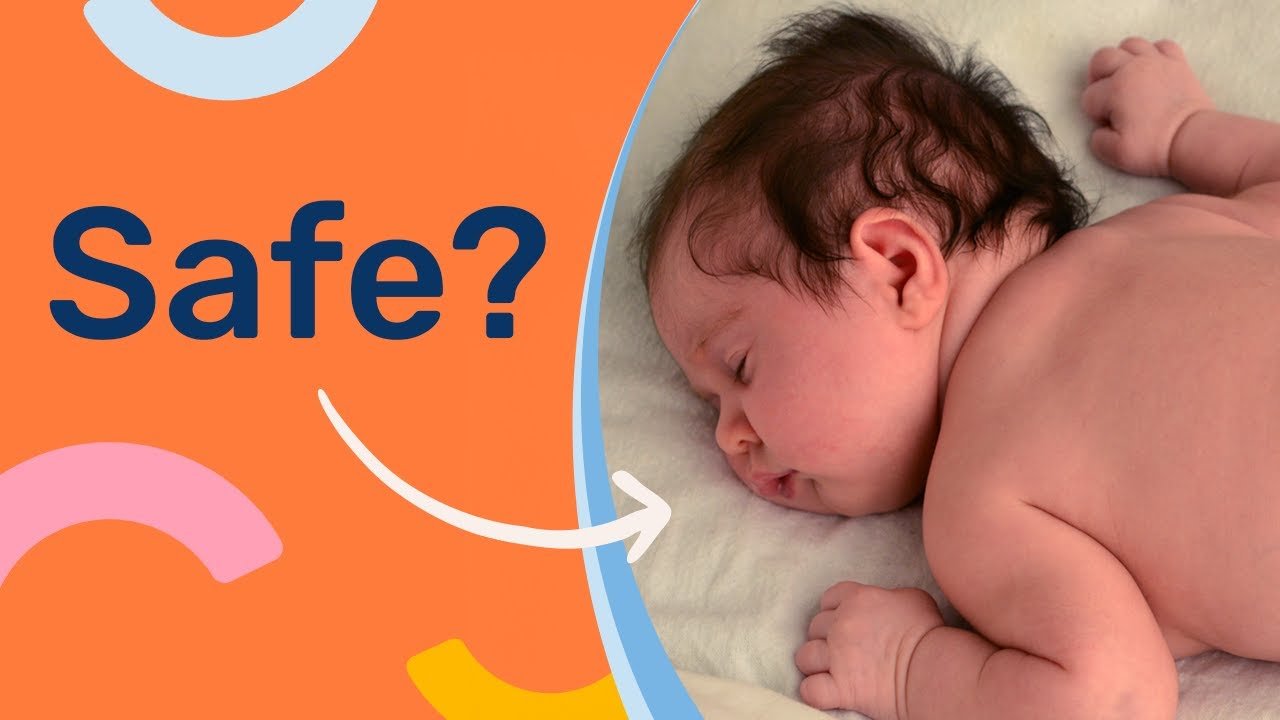When you’re a new parent, there’s a lot of information to navigate, especially when it comes to ensuring your baby’s safety while sleeping. In Emma Hubbard’s video, “The Truth About Tummy Sleeping – What Parents Need to Know,” she covers the safest baby sleep position and the risks associated with other sleeping positions, particularly those that increase the risk of Sudden Infant Death Syndrome (SIDS). It’s important to be informed about these risks and make the best choices for your little one’s safety and well-being.
As a parent, it’s natural to seek advice and try different methods to help your baby sleep better. While it may seem tempting to switch to tummy sleeping for longer periods of rest, Emma Hubbard explains why back sleeping is the safest option to reduce the risk of SIDS. By understanding the science behind sleep positions and the potential dangers of unsafe sleeping habits, you can make informed decisions for your baby’s health and safety.

The Importance of Baby Sleep Safety
Ensuring the safety of your baby during sleep is of utmost importance as it can significantly reduce the risk of Sudden Infant Death Syndrome (SIDS). By understanding safe sleeping positions and following the recommendations provided by the American Academy of Pediatrics, you can create a safe sleep environment for your little one.
Understanding Sudden Infant Death Syndrome (SIDS)
SIDS is a devastating syndrome that can occur in infants between the ages of 1 month to 1 year old. It is the leading cause of death in babies within this age group. While the exact cause of SIDS is not yet fully understood, research has shown that certain sleep positions can increase the risk. By creating a safe sleeping environment and placing your baby in the recommended sleeping position, you can reduce the likelihood of SIDS.
Significance of Safe Sleeping Positions
Safe sleeping positions play a crucial role in preventing SIDS and ensuring your baby sleeps soundly. By understanding the risks associated with unsafe sleeping positions, you can make informed decisions to protect your baby during their sleep.
Recommendations from American Academy of Pediatrics
The American Academy of Pediatrics provides guidelines to help parents create a safe sleep environment for their infants. By following these recommendations, you can reduce the risk of SIDS and ensure your baby sleeps safely.
Back Sleeping as the Safest Option
The AAP recommends placing babies on their back to sleep as the safest sleeping position. This position allows for clear airways, reduces the risk of choking on vomit, and helps prevent suffocation and overheating. Back sleeping has been shown to significantly lower the risk of SIDS and is the preferred sleeping position for infants.
Importance of a Safe Sleep Environment
Creating a safe sleep environment for your baby is essential to promote healthy sleep habits. Ensure that your baby sleeps on a flat, firm surface with no soft items such as bumper pads, toys, or loose blankets. By eliminating potential hazards in the sleep environment, you can create a safe space for your baby to rest peacefully.
Benefits of Room Sharing
The AAP recommends room sharing with your baby for the first 6-12 months of life. Room sharing has been shown to reduce the risk of SIDS by nearly 50%. By having your baby sleep on a separate surface within the same room as you, you can monitor their sleep more closely and respond quickly to any needs during the night.
Benefits of Back Sleeping
Placing your baby on their back to sleep offers numerous benefits that contribute to their safety and well-being.
Clear Airways and Reduced Choking Risk
Back sleeping allows babies to keep their airways clear, reducing the risk of choking on vomit or regurgitated milk. The positioning of the trachea above the esophagus makes it difficult for vomit to reach the lungs, lowering the chances of choking during sleep.
Prevention of Suffocation and Overheating
Back sleeping helps prevent suffocation and overheating by allowing for better air circulation and body temperature regulation. By ensuring your baby sleeps on their back, you can minimize the risk of environmental factors that could lead to SIDS.
Unsafe Sleeping Positions for Babies
Certain sleeping positions can pose risks to your baby’s safety and increase the likelihood of SIDS. Understanding these risks can help you make informed decisions about your baby’s sleep position.
Risk Factors of Tummy Sleeping
Sleeping a baby on their tummy significantly increases the risk of SIDS. Babies in this position are less reactive to noise, have a higher arousal threshold, and may experience a sudden decrease in blood pressure and heart rate, contributing to the risk of SIDS.
Dangers of Side Sleeping
Side sleeping can be unsafe for babies as they are likely to roll onto their tummy, increasing the risk of suffocation and choking. The compromised safety of side sleeping compared to back sleeping makes it a riskier position for infants.
Increased Risk with Changing Sleeping Positions
Swapping between different sleeping positions can elevate the risk of SIDS for babies. Consistently placing your baby on their back for sleep can help reduce the risk associated with changing sleeping positions and ensure their safety during sleep.
Dangers of Tummy Sleeping
Sleeping a baby on their tummy can have detrimental effects on their safety and well-being.
Less Reactive to Noise
Babies sleeping on their tummy are less responsive to external stimuli, making it harder to detect potential dangers or disturbances during sleep.
Increased Arousal Threshold
Tummy sleeping increases a baby’s arousal threshold, meaning they need stronger stimuli to wake up. This decreased responsiveness can be dangerous in emergency situations.
Higher Risk of Choking on Vomit
The positioning of the trachea and esophagus when a baby sleeps on their tummy increases the risk of choking on vomit or regurgitated milk. This can lead to serious health complications and endanger your baby’s life.
Sudden Changes in Blood Pressure and Heart Rate
Tummy sleeping can result in sudden changes in blood pressure and heart rate control, which can contribute to the risk of SIDS. These fluctuations can impact your baby’s overall health and safety during sleep.
Potential Decrease in Oxygen Levels
Breathing in their own air while sleeping on their tummy can lead to carbon dioxide buildup and lower oxygen levels. This decreased oxygen intake can pose serious risks to your baby’s health and increase the likelihood of SIDS.
Risks of Side Sleeping
Side sleeping can present risks to your baby’s safety and increase the chances of SIDS.
Likelihood of Rolling onto Tummy
Babies sleeping on their side are prone to rolling onto their tummy, which can expose them to the same risks associated with tummy sleeping. The likelihood of this occurrence makes side sleeping a less safe option for infants.
Compromised Safety Compared to Back Sleeping
Side sleeping compromises the safety of your baby compared to back sleeping. The risk of rolling onto their tummy and other potential dangers make side sleeping a less secure sleeping position for infants.
Advice for Parents on Safe Sleep Practices
As a parent, it’s crucial to prioritize safe sleep practices to ensure the well-being of your baby. Following these guidelines can help create a safe sleep environment and reduce the risk of SIDS.
Always Place Baby on Their Back for Sleep
Consistently placing your baby on their back for sleep is the safest option to reduce the risk of SIDS. By maintaining this sleeping position, you can promote a safe and secure sleep environment for your little one.
Avoid Swapping Between Different Sleep Positions
Preventing frequent changes in your baby’s sleep position can lower the risk of SIDS. By sticking to a consistent back sleeping routine, you can minimize potential hazards and ensure your baby’s safety during sleep.
Additional Resources for Better Sleep
Seeking additional resources and guidance can help improve your baby’s sleep quality and safety.
Tips for Helping a Newborn Sleep Better
Exploring strategies and tips to help your newborn sleep better can enhance their sleep quality and overall well-being. By implementing these tips, you can create a conducive sleep environment for your baby.
Free Developmental Checklist for Baby’s First Year
Utilizing developmental checklists can help track your baby’s progress and ensure they are meeting important milestones. By monitoring their development, you can address any concerns early on and provide the necessary support for their growth.
Professional Guidance and Disclaimer
Seeking medical advice from a professional is essential to ensure your baby’s safety and well-being.
Always Seek Medical Advice from a Professional
Consulting with a healthcare provider or pediatrician can offer valuable insights and guidance on safe sleep practices for infants. Professional advice is crucial in addressing any concerns or questions related to your baby’s health.
Channel Content Not a Substitute for Medical Advice
While informational resources can provide helpful tips and recommendations, they are not a replacement for professional medical advice. It’s important to rely on the expertise of healthcare professionals for personalized guidance on your baby’s health and safety.
Conclusion
Prioritizing baby sleep safety is essential for promoting a healthy and secure sleep environment. By following the recommendations from the American Academy of Pediatrics, parents can create a safe sleep environment for their infants and reduce the risk of SIDS. Educating yourself on safe sleep practices and understanding the importance of back sleeping can help ensure your baby sleeps soundly and safely.

